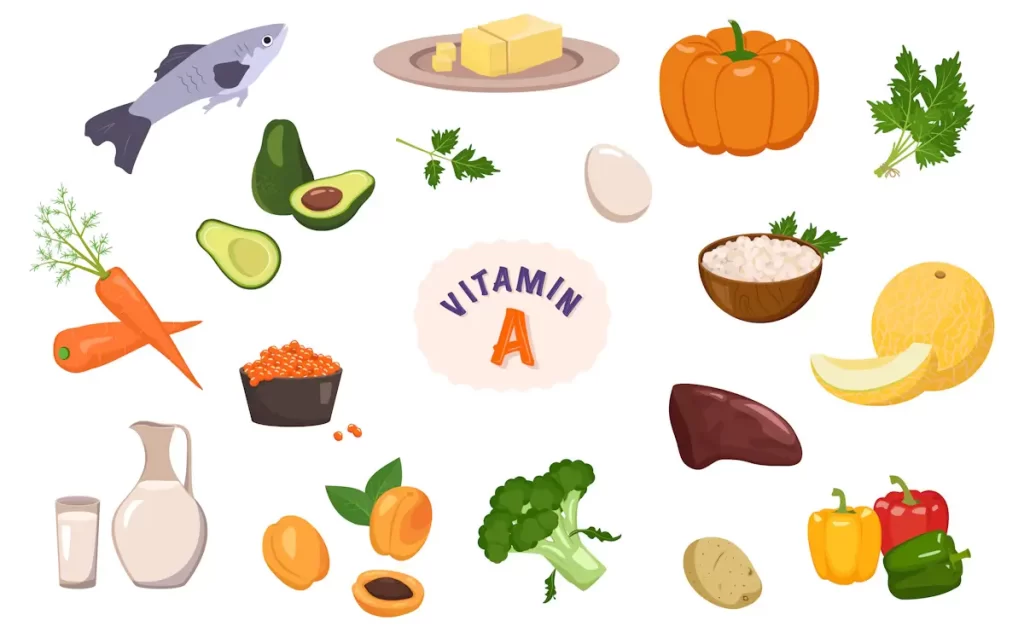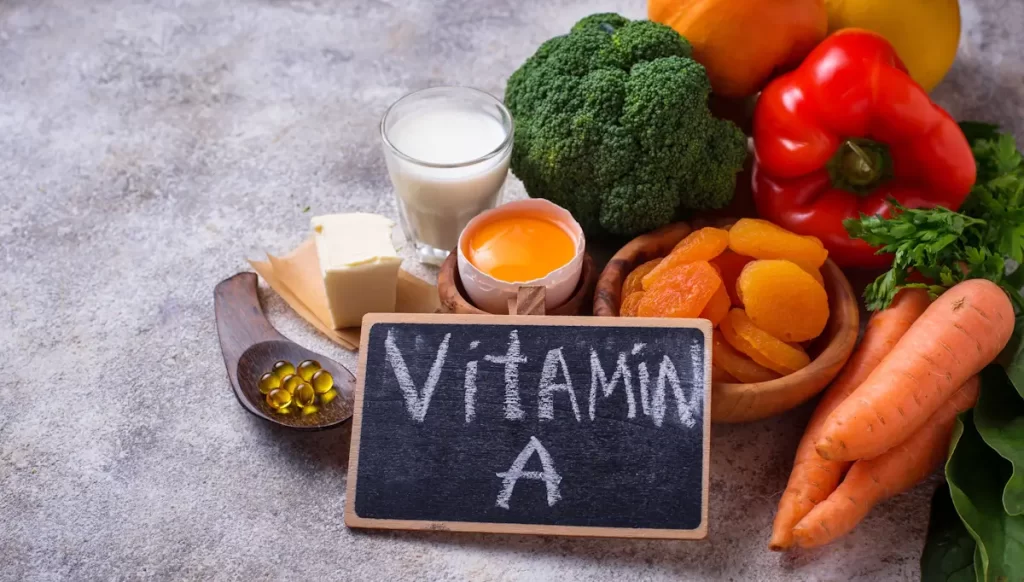Do you know why Vitamin A matters for your health? It helps with vision, boosts the immune system, and supports healthy skin. This blog will explain its benefits, where to find it, and how it works in the body.
Thank you for reading this post, don't forget to subscribe!Keep reading—your health could depend on it!
Key Takeaways
- Vitamin A supports vision, skin health, and a strong immune system. A lack of it can cause night blindness, dry skin, or weakened immunity.
- Foods like sweet potatoes, carrots, kale, beef liver, and dairy provide Vitamin A. Beta-carotene-rich vegetables are great for plant-based options.
- The RDA is 900 mcg for men and 700 mcg for women daily. Too much can lead to toxicity with symptoms like liver damage or bone pain.
- At-risk groups include children under 5 years old, pregnant women in developing countries, and people with digestion issues like celiac disease.
- Pairing Vitamin A with healthy fats improves absorption. Zinc also helps the body process this vital nutrient effectively.
What is Vitamin A?
Vitamin A is a fat-soluble vitamin that your body needs for many functions. It helps keep your eyes, skin, and immune system strong.
Definition and Importance
Vitamin A is a fat-soluble vitamin stored in the liver as retinyl esters. The body converts these into active forms like all-trans-retinol for various functions. It acts as an antioxidant, helping reduce free radicals that can cause heart disease and cancer.
The recommended dietary allowance (RDA) is 900 mcg for adult men and 700 mcg for women daily. Proper intake supports vision, immune function, and skin health while protecting against oxidative stress.
Let’s explore its essential roles next….
Essential Functions of Vitamin A
Vitamin A helps your body in many ways—it supports good vision, boosts your immune system, and keeps your skin healthy. Keep reading to explore its crucial roles!
Vision Support
Retinal function relies on vitamin A. It helps form rhodopsin, a protein in the eyes that detects light and color. In dim lighting, this ensures clear vision. Without enough retinoic acid from this nutrient, night blindness can occur.
Dry eyes and other eye problems may also result from deficiency. This can increase risks of issues like age-related macular degeneration (AMD). Foods rich in beta-carotene—like sweet potatoes and green leafy vegetables—help maintain eye health by providing provitamin A carotenoids.
Vitamin A is vital for eyesight—it supports both clarity at night and overall retinal health.
Immune System Enhancement
Vitamin A plays a key role in strengthening the immune system. It supports lymphocyte development, helping the body fight infections effectively. This vitamin also boosts antibody responses, making it vital for overall immune health.
People with low levels of vitamin A may struggle with weakened defenses against diseases.
A deficiency can disrupt T-cell function and reduce CD4 and NK cells, both crucial for immunity. About 125 million individuals face such deficiencies worldwide, leaving them prone to illnesses.
Including food sources like sweet potatoes or beef liver helps maintain optimal levels of this fat-soluble vitamin—a simple step toward better health protection.
Skin Health Maintenance
Retinoic acid helps skin cells grow and repair. It plays a key role in healing wounds. This process depends on the right amount—too little or too much can cause problems. UV radiation lowers retinoid levels, which may damage the skin over time.
Healthy levels of Vitamin A improve skin texture and tone. They aid in melanocyte differentiation, which affects pigmentation. Foods like sweet potatoes and green leafy vegetables provide beta carotene, a form of this nutrient that supports glowing skin.

Health Benefits of Vitamin A
Vitamin A plays a key role in keeping your body healthy. It supports critical functions like protecting cells and promoting overall well-being.
Preventing Age-related Macular Degeneration
A diet rich in carotenoids like lutein and zeaxanthin can help lower the risk of age-related macular degeneration (AMD) by up to 25%. These nutrients are found in green leafy vegetables, orange vegetables, and fortified foods.
Vitamins C and E also support eye health by fighting oxidative stress caused by free radicals.
Studies such as AREDS2 show that specific vitamin combinations can reduce advanced AMD progression by another 25%. Dietary supplements containing beta-carotene, zinc, or retinol activity equivalents (RAE) may add extra protection.
Balancing these with a healthy dietary pattern ensures maximum benefits for aging eyes.
Reducing Risk of Certain Cancers
Higher intakes of retinol and carotenoids can lower the risk of several cancers, like bladder and breast cancer. Retinoids, derived from vitamin A, may slow the growth of cancer cells in ovarian tumors.
Eating foods rich in beta-carotene or alpha-carotene is linked to a reduced risk of lung cancer.
Smokers with high levels of carotenoids saw major benefits too—alpha-carotene cut their lung cancer risk by 46%, while beta-cryptoxanthin lowered it by 61%. Whole foods work better than beta-carotene supplements, which might harm smokers instead.
Consuming green leafy vegetables, orange veggies, and sweet potatoes helps protect your body naturally.
Supporting Reproductive Health
Vitamin A plays a huge role in reproductive health for both men and women. It aids in sperm cell production, making it crucial for male fertility. For women, it supports the development of vital organs during pregnancy, ensuring proper growth for the fetus.
A deficiency can cause infertility or complications with conception. On the other hand, excessive intake during pregnancy may lead to birth defects. Balanced doses following recommended dietary allowances (RDA) are key to avoiding these risks while supporting healthy reproduction.
Sources of Vitamin A
You can get Vitamin A from both foods and supplements. Eating a variety of colorful fruits, vegetables, and animal products helps keep your intake balanced.
Dietary Sources
Vitamin A comes from many foods. It is available in animal products and plant-based sources.
- Sweet potatoes are rich in provitamin A carotenoids. One medium sweet potato provides over 100% of the recommended dietary allowance (RDA).
- Carrots are another excellent source, with one cup providing 184% of your daily vitamin A needs.
- Kale and spinach also offer provitamin A carotenoids. These green leafy vegetables are nutritious and low in calories.
- Beef liver contains preformed vitamin A, making it one of the richest sources available. Just three ounces can exceed daily requirements for adults.
- Egg yolks provide smaller amounts of preformed vitamin A but remain a good addition to your diet.
- Cheddar cheese and butter include preformed vitamin A, though they should be eaten in moderation due to their saturated fat content.
- Cod liver oil is a concentrated source of preformed vitamin A and has antioxidant properties too.
- Salmon delivers both protein and essential nutrients, including vitamin A, for improved health.
- Red peppers contain provitamin A carotenoids while adding color and flavor to meals.
- Cantaloupe offers natural sweetness along with provitamin A carotenoids for eye health.
All these foods help meet nutrient intakes easily when paired with dietary fats that improve absorption.
Supplemental Sources
Supplements can help increase vitamin A levels if food sources are not enough. They are especially useful for those with deficiencies or certain health conditions.
- Preformed vitamin A supplements, like retinyl palmitate or retinyl acetate, are widely available and highly effective. These are fat-soluble forms often found in multivitamins.
- Beta-carotene supplements provide provitamin A carotenoids, which the body converts into usable vitamin A. These are plant-based and good for people avoiding animal products.
- Liquid drops of vitamin A work well for young children and premature infants who cannot take pills. These are commonly used in developing countries to prevent deficiency.
- Chewable tablets or gummies make supplementation easier for kids or adults who dislike swallowing pills. They come in sweet flavors but must be taken as directed to avoid risks.
- Prescription retinoids may be necessary for individuals with severe issues like cystic fibrosis or Crohn’s disease. Doctors monitor their use closely to prevent toxicity.
- High-dose supplements might help reduce night blindness caused by a lack of vitamin A. Such interventions should only occur under medical supervision.
- Many prenatal vitamins include preformed vitamin A to support pregnancy needs while reducing the risk of birth defects with controlled doses.
- Some fortified foods or beverages contain added vitamin A and act as supplemental options—for example, breakfast cereals or dairy products enriched with retinyl esters.
- Water-miscible versions of fat-soluble vitamins exist for those with absorption problems due to liver damage or celiac disease.
- Supplements must follow the tolerable upper intake level (UL) guidelines set by health authorities, like the Food and Nutrition Board, to prevent hypervitaminosis A risks linked to excessive consumption.

Vitamin A Deficiency
Vitamin A deficiency can cause serious health problems, such as night blindness. It often affects people who don’t eat enough animal products or colorful vegetables like sweet potatoes and carrots.
Signs and Symptoms
Deficiency in vitamin A can lead to serious health problems. Early detection of signs can help prevent complications.
- Night blindness makes it hard to see in dim light or darkness. It often occurs as one of the first warning signs.
- Dry skin or xeroderma causes rough, scaly patches on the skin. This happens due to a lack of moisture production.
- Frequent infections become common due to a weakened immune system. Respiratory and gastrointestinal infections are examples.
- Bitot spots appear as foamy white patches on the eye’s surface. These are a clear indicator of severe deficiency.
- Ocular symptoms worsen when serum retinol levels drop below 10 mcg/dL. This might progress to complete vision loss if unchecked.
- Xerophthalmia leads to dryness and damage in the eyes, causing blindness over time without treatment.
- Delayed growth in children may occur due to poor development caused by low vitamin A intake.
- Low blood retinol levels, under 20 mcg/dL, confirm deficiency in most cases during medical tests.
- Fatigue and weakness often arise because this nutrient supports vital body functions that give energy.
- Cracked lips or sores around the mouth also point to insufficient intake, affecting skin and tissue repair processes.
At-Risk Groups
Some groups face a higher risk of vitamin A deficiency. This can lead to serious health issues if not addressed.
- Premature infants are at high risk due to low vitamin A stores at birth. Their underdeveloped bodies struggle to absorb enough nutrients.
- Children under five years old, especially in rural areas, often lack vitamin A. Studies show about one-third of kids this age suffer from this deficiency worldwide.
- Pregnant women in developing countries need more vitamin A for themselves and their babies. Without it, they risk complications and poor birth outcomes.
- Breastfeeding mothers with low vitamin A levels can’t supply enough of the nutrient through breast milk for their child’s growth and immune support.
- People with cystic fibrosis face absorption problems due to pancreatic issues, putting them at risk of deficiency.
- Those living in poverty or lacking access to nutritious foods struggle to meet dietary needs for essential nutrients like provitamin A carotenoids.
- Adults with celiac disease or other digestive disorders may have trouble absorbing fat-soluble vitamins like vitamin A, leading to deficiencies over time.
These vulnerable groups require special attention to avoid severe health effects such as night blindness or increased mortality risks among children under five years old.
Health Risks from Excessive Vitamin A
Too much Vitamin A can harm your body. It may cause headaches, dizziness, or even serious health issues like liver damage.
Toxicity Symptoms
Vitamin A toxicity happens when you take too much of it. This is also called hypervitaminosis A and can harm your body.
- Vision problems can occur, like blurry vision or seeing spots.
- Nausea and vomiting are common early signs of toxicity.
- Joint pain may develop, making movement uncomfortable.
- Dry skin and peeling can show up after toxic levels are reached.
- Liver damage is a serious risk from consuming high doses over time.
- Jaundice, where the skin turns yellow, might signal liver issues caused by excess intake.
- Increased sunlight sensitivity can happen, causing irritation outdoors.
- Headaches might result from increased cranial pressure due to acute toxicity.
- Bone pain or fractures could be linked to long-term excessive intake.
- In rare cases, birth defects can affect babies if pregnant women overdose on vitamin A.
Safe Dosage Recommendations
The recommended dietary allowance (RDA) for preformed vitamin A is 900 mcg per day for men and 700 mcg per day for women. Pregnant women need to be cautious, as too much may increase the risk of birth defects.
Beta-carotene supplements and provitamin A carotenoids do not have a tolerable upper intake level (UL), but excessive amounts can still cause issues.
The UL for preformed vitamin A in adults is set at 3,000 mcg RAE daily. Consuming more than this over time could lead to toxicity symptoms like liver damage or bone pain. For safety, follow dosage guidelines on multivitamin supplements and avoid taking high doses unless advised by a doctor.
People using medications like retinoids should consult their healthcare provider since interactions may occur.
Interactions with Medications
Vitamin A can interact with some drugs, like retinoids. These interactions may change medicine effects or increase side effects.
Retinoids
Retinoids are synthetic forms of vitamin A often used in skincare. Doctors prescribe them to treat severe acne and other skin disorders. They work by speeding up skin cell turnover and reducing inflammation.
Retinoic acid, a key component, helps repair damaged skin.
These treatments can have side effects. High doses may lead to toxicity or liver damage if not monitored by a doctor. Pregnant women must avoid retinoids due to the risk of birth defects.
Medications like certain antibiotics may also interact with retinoids, affecting how well they work in the body. Always consult your healthcare provider before starting such treatments for safety.
Other Known Interactions
High doses of Vitamin A can interact with anticoagulants, increasing the risk of bleeding. Combining it with hepatotoxic drugs may worsen liver damage. Orlistat, a weight-loss medication, might lower vitamin A absorption, leading to possible deficiency over time.
Smokers and heavy drinkers should avoid retinoid supplements due to the increased risk of side effects. Combining large amounts of Vitamin A with Bexarotene may heighten toxicity risks or cause severe reactions.
Always monitor intake if using these substances together.

Vitamin A and Healthful Diets
Eating foods rich in Vitamin A helps support your overall health. Pair it with other nutrients for a balanced and nourishing diet.
Incorporating Vitamin A into Daily Diet
Adding Vitamin A to your daily meals can improve your health. It supports vision, skin, and immune function while protecting against certain diseases.
- Include orange vegetables like sweet potatoes and carrots. These are rich in provitamin A carotenoids that convert to Vitamin A in your body.
- Introduce dairy products like milk and cheese. They provide preformed Vitamin A, which is ready for use by the body.
- Eat ripe fruits such as mangoes or cantaloupes. They’re easy to add as snacks or desserts while boosting your vitamin intake.
- Use animal products like beef liver or fish oils sparingly but effectively. They are dense sources of retinol and retinyl esters, key forms of Vitamin A.
- Cook yellow tubers like yams for better nutrient absorption compared to some leafy greens.
- Add green leafy vegetables such as spinach or kale to soups, salads, or smoothies for an extra dose of plant-based nutrients like beta-carotene.
- Try antioxidant-rich whole grains with fortified breakfast cereals that often contain added Vitamin A for a quick nutritional boost.
- Limit reliance on supplements unless advised by a doctor since high doses risk toxicity symptoms like liver damage or birth defects.
The next section will explore signs and risks related to Vitamin A deficiency…
Balancing Vitamin A with Other Nutrients
Vitamin A works best when paired correctly with other nutrients. Eating a balanced diet ensures proper Vitamin A use in the body.
- Pair Vitamin A with Fats
This vitamin is fat-soluble, so dietary fats help absorption. Healthy fats from avocados, olive oil, or nuts can improve its intake. - Include Vitamin D
Both vitamins are important for bone health and immune function. They work together to maintain an effective system. - Add Zinc-Rich Foods
Zinc supports Vitamin A metabolism and transport within the body. Foods like beans, shellfish, and lean meats are excellent sources. - Focus on Antioxidants
Beta-carotene, a provitamin A carotenoid, helps protect against free radicals. Sweet potatoes and orange vegetables provide this benefit. - Avoid Overloading Supplements
High doses of Vitamin A supplements may reduce the absorption of other nutrients like Vitamin E or K. Stick to natural sources or follow your recommended dietary allowance (RDA). - Consider Protein Intake
Proteins aid retinol-binding proteins that carry Vitamin A through the bloodstream. Include dairy products, legumes, or eggs for balance. - Limit Alcohol Consumption
Alcohol reduces liver stores of Vitamin A and affects its metabolism negatively over time. Moderation is important for nutrient balance. - Consume Green Leafy Vegetables
These vegetables provide provitamin A along with important vitamins like C and K for overall health improvement. - Watch Fiber Levels in Diets
Too much fiber might interfere with absorption of fat-soluble vitamins including Vitamin A—so avoid excessive intake. - Monitor Iron Levels
Low iron may hinder how your body processes Vitamin A effectively by reducing storage capacity in tissues where it’s needed most.
Conclusion
Vitamin A plays a big role in keeping your body healthy. It helps with vision, boosts immunity, and supports skin health. You can get it from foods like sweet potatoes, carrots, and dairy or through supplements if needed.
Be careful not to take too much—it can harm you. Balance is key for a strong and vibrant life!
